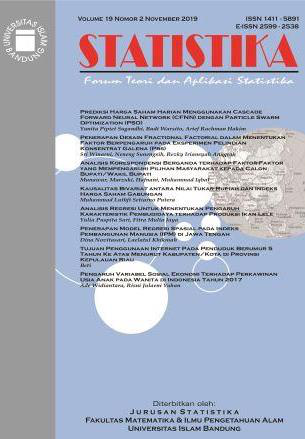Regresi Nonparametrik Multivariabel dengan Pendekatan Spline Truncated pada Kasus Tuberculosis
DOI:
https://doi.org/10.29313/statistika.v22i1.506Keywords:
Regresi Nonparametrik, Spline Truncated, GCV, TuberculosisAbstract
ABSTRAK
Regresi nonparametrik merupakan suatu metode statistika yang digunakan untuk mengetahui pola hubungan antara variabel prediktor dengan respon ketika tidak diketahui bentuk fungsi regresinya dimana kurva regresi hanya diasumsikan smooth. Spline truncated adalah suatu pendekatan ke arah pencocokan data dengan tetap memperhitungkan kemulusan kurva yang memiliki sifat tersegmen kontinu sehingga memberikan fleksibilitas dan efektif menyesuaikan diri dalam menjelaskan karakteristik lokal dari fungsi data. Tujuan penelitian ini adalah untuk mendapat model regresi nonparameterik multivariabel dengan pendekatan spline truncated dan mengetahui faktor-faktor yang berpengaruh terhadap jumlah kasus tuberculosis di Kalimantan Timur, Kalimantan Selatan dan Kalimantan Barat tahun 2019. Hasil menunjukkan bahwa model regresi nonparametrik spline truncated terbaik dalam memodelkan jumlah kasus tuberculosis adalah dengan tiga titik knot. Model ini memiliki nilai generalized cross validation (GCV) yang paling minimum sebesar 40.813,24, dengan nilai R2 sebesar 95,84%. Berdasarkan hasil pengujian signifikansi parameter model, disimpulkan bahwa faktor-faktor yang memengaruhi jumlah kasus tuberculosis di Kalimantan Timur, Kalimantan Selatan dan Kalimantan Barat tahun 2019 adalah persentase penduduk miskin, persentase tenaga kesehatan terlatih, persentase keluarga memperoleh sanitasi, dan persentase gizi buruk masyarakat.
ABSTRACT
Nonparametric regression is a statistical method used to determine the pattern of the relationship between the predictor variable and the response when the form of the regression function is unknown where the regression curve is only assumed to be smooth. The truncated spline is an approach towards data matching while taking into account the smoothness of the curve which has continuous segmented properties so as to provide flexibility and effectively adapt to explain the local characteristics of the data function. The purpose of this study was to obtain a multivariable nonparametric regression model with a spline truncated approach and find out the factors that influence the number of tuberculosis cases in East Kalimantan, South Kalimantan and West Kalimantan in 2019 using the data from Indonesian Central Bureau of Statistics. The results show that the spline truncated nonparametric regression model is the best in modeling the number of cases. tuberculosis is with three point knots. This model has the minimum generalized cross validation (GCV) value of 40,813.24, with an R2 value of 95.84%. Based on the results of testing the significance of the model parameters, it was concluded that the factors that influenced the number of tuberculosis cases in East Kalimantan, South Kalimantan and West Kalimantan in 2019 were the percentage of poor people, the percentage of trained health workers, the percentage of families receiving sanitation, and the percentage of poor nutrition in the community.
References
Eubank, R.L. (1999). Nonparametric Regression and Spline Smoothing 2nd. New York: Marcel Dekker Inc.
Putra, I.M.B., Srinadi, I.G.A.M., Sumarjaya, I.W. (2015). “Pemodelan Regresi Spline (Studi Kasus: Herpindo Jaya Cabang Ngaliyan)”. Jurnal Matematika. 04(03),110-114.
Wahba, G. (1990). Spline Models for Observation Data. Society for Industrial and Applied Mathematics. Philadelphia: Pennsylvania
















